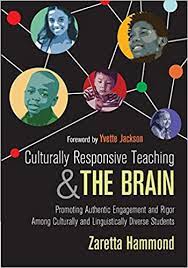Author: Zaretta Hammond
ISBN: 978-1-4833-0801-2
APA Style Citation
Hammond, Z. (2015). Culturally responsive teaching and the brain. Thousand Oaks, CA: Corwin.
Buy this Book
https://www.amazon.com/Culturally-Responsive-Teaching-Brain-Linguistically/dp/1483308014
| activity_culturally_responsive_teaching_.pdf |
Zaretta Hammond attended a progressive public school in San Francisco, CA rather than the school in the projects where she lived because her mother used Zaretta’s grandparents’ address knowing that the way to a better life was through a good education. When Hammond was in 5th grade, a court order mandated that San Fransisco schools desegregate and her school became instantly more diverse. Hammond recognized that the children coming from schools near where she lived had trouble keeping up with the material not because they were not bright but because they came from schools with vastly different expectations and instruction. By the time these students were in middle school the differences in level of education were pronounced. Hammond recognized this not as an achievement gap but an opportunity gap, one that still exists today in neighborhoods with socioeconomic challenges and often in communities of color.
Culturally Responsive Teaching and the Brain combines neuroscience with the practicality of how the brain and body can impact academic performance. Hammond has created a comprehensive explanation of how instructors can move dependent learners to independent learners by being intentional and reflective about their own classroom organization, their interactions with students, and with an understanding of the biological mechanisms that impact motivation and learning. Hammond describes the book as, “a pedological approach firmly rooted in learning theory and cognitive science”(p.15). Hammond asks educators to acknowledge that many students face unearned disadvantages because of their race, gender, class or language, and she sets out to eliminate these disadvantages in an educational setting. Schools are an extension of culture but when a school environment identifies one particular culture or set of beliefs as “correct” or bases rules and celebrations off of one culture, many others feel excluded and start to believe that school is not for them.
Structures and traditions may be exclusive by giving some students religious holidays off of school and not recognizing others, or organizing school or class events around traditions/celebrations that only some students participate in. In addition, less obvious but powerful forces such as implicit bias may reinforce a system in which there is a belief that some students are more capable of academic success than others because of their gender, ethnicity or the color or their skin. Hammond points out that by third grade many culturally and linguistically diverse students are one or more years behind in reading, which she identifies as intellectual apartheid. With proper scaffolding however, Hammond lays out a path in which all students can find academic success. Often, when students are successful in school students, teachers, and parents attribute the success to personal characteristics of the student and do not take into consideration that the organization of the school had also contributed to the students’ success. The same can be true for those for whom the system does not work. We are quick to make a personal attribution about the students’ lack of effort or ability when the structure of the school or implicit biases may be playing a role in the students’ day-to-day educational experience. We need to start looking at situational factors that may also limit students’ progress.
Hammond describes the role of the brain in learning and pays particular attention to the limbic system, which is often considered the emotional center of the brain. When a person is feeling threatened or stereotyped their limbic system is active, which Hammond labels as “amygdala hijack”. When this occurs students are unable to focus on what is happening in the lesson because of many factors such as stereotype threat, microaggressions, or other factors that make a student feel like they are singled out and they cannot live up to their full potential. Learning involves the development of new neural pathways and if those cannot be practiced shortly after learning something they will be lost. Students who are under a perceived or real threat cannot transfer short-term to long-term memories and gradually fall further and further behind. Often those that feel most threatened are non-English speakers and students of color who consciously or unconsciously detect threats to their safety which impedes learning.
In the second half of the book, Hammond explains how teachers can check their own bias to create more inclusive classrooms in which all students feel welcomed and that they can succeed. She provides scaffolds that can move dependent learning to more independent critical thinkers. Hammond proposes that culturally responsive teaching is not a set of instructional strategies but rather a mindset in which one must be conscious of their actions, words, body language and consider the subtle and not so subtle messages they may be giving to students. She proposes the method of description, interpretation, and evaluation in which educators consider their own cultural and ethnic experiences and deeply consider how this impacts their world view and how it may influence their behaviors and thoughts. This is a book for all educators who want to create a safe place in which all students can learn and reach their potential.
Other Related Resources
Zaretta Hammond’s Blog: Culturally Responsive Teaching and the Brain
https://crtandthebrain.com/about/
Zaretta Hammond: Lecture on Culturally Responsive Teaching
https://www.youtube.com/watch?v=O2kzbH7ZWGg
Collaborative Classroom: A Conversation about Instructional Equity
https://www.collaborativeclassroom.org/blog/a-conversation-about-instructional-equity-with-zaretta-hammond/
Teaching for Justice (formerly Teaching Tolerance)
https://www.learningforjustice.org/author/zaretta-hammond
Turn and Talk ASCD: Interview with Zaretta Hammond
https://www.ascd.org/el/articles/zaretta-hammond-on-coaching-and-culturally-responsive-teaching
Social Emotional Learning and School Safety Podcast
https://selcenter.wested.org/resource/start-with-responsive/#
Edutopia: How to get started with Culturally Responsive Teaching
https://www.edutopia.org/article/getting-started-culturally-responsive-teaching
Psychological Concepts and Figures
Amygdala
Brainstem
Cerebellum
Collectivism
Cultural archetypes
Dopamine
Fluid intelligence
Implicit bias
Individualism
Information processing
Just-world phenomenon
Long-term memory
Microaggressions
Mindset
Neocortex
Neural pruning
Oxytocin
Reticular activating system
Schema
Short-term memory
Surface culture

 RSS Feed
RSS Feed